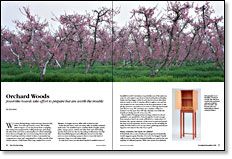Orchard Woods
Jewel-like boards take effort to prepare but are worth the trouble
Synopsis: Jon Arno has worked with orchard wood for decades, and he shares his affection for them here. It does require effort to prepare the wood, but he offers tips on using the wood so you can benefit from the lovely figure, too. Most fruit and nut trees actually come from just three botanical families. Growing trees for fruit gives the wood a beautiful marbled appearance, though heavy pruning can lead to the formation of reaction wood, which is prone to shrinkage. Arno also offers side information on drying orchard wood.
We were driving along a rural road near Traverse City, Mich., four teen-age boys in a new, 1957 Pontiac station wagon, on our way home from a camping trip. Cherry trees peppered the rolling landscape, and along the side of the road were scattered piles of orchard trimmings. Cut to firewood length, the wood was being thrown into the back of a pickup truck by orchard workers. I persuaded my companions to stop, and I negotiated for a dollar’s worth of the choicer pieces—a half-dozen 18-in. logs, maybe 8 in. or so in diameter. So began my love affair with orchard woods.
In the decades since, and over many miles of widely scattered rural roads, I’ve stumbled upon countless finds of apple, peach, plum, orange, pecan, walnut and other fruit- and nut-bearing species. Most of it was free for the taking. It still amazes me that these beautifully figured and brilliantly colored woods often serve no more enduring a purpose than to warm the back of someone’s legs on a cold winter night.
So why don’t more woodworkers tap this bountiful source of beautiful woods? Convenience is probably one of the main reasons. It’s a lot easier to go down to the local hardwood lumber dealer and buy bigger, wider boards that have been kiln dried and are ready to work. It requires effort to gather, saw and season orchard woods, and results are far from guaranteed. A simple jig, however, can make it a lot easier to turn logs into boards, and there are a number of tips I’ve learned over the years that will help minimize loss while the boards are drying.
The benefits of foraging and processing orchard woods are qualitative, not quantitative. Even though the boards you get from any given batch are rarely sufficient for a major piece of furniture, the special character of this wood is precious beyond the time and toil expended. And for many woods, including virtually all of the fruit woods except cherry, gathering and seasoning your own may be the only way to get it.
Many varieties, but most are related
At first blush, the scores of fruits and nuts grown domestically would suggest a great diversity of wood to be foraged. Genetically, however, only three botanical families account for the vast majority of cultivated species. With a few choice but relatively rare exceptions (persimmon, an ebony relative, comes to mind), orchard woods fit neatly into the rue, walnut and rose families.
From Fine Woodworking #115
For the full article, download the PDF below:
Fine Woodworking Recommended Products

AnchorSeal Log and Lumber End-Grain Sealer

DeWalt 735X Planer

Ridgid R4331 Planer






















Log in or create an account to post a comment.
Sign up Log in